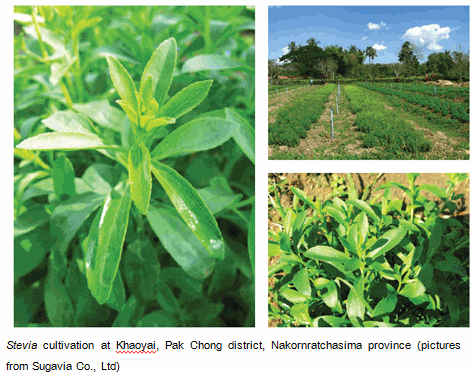
|
Eng |
Pisamai Kulkanjanatorn PhD, Pharmacist, Assoc. Prof., Department of Pharmaceutical Chemistry, Faculty of Pharmacy, Mahidol University
Sweetness is the favorite taste for everyone. Eating too much sugar (sucrose) or artificial sweetener, is not good for health. Nowadays, the natural sweetener from stevia is a good choice for sugar substitution because it is up to 300 times sweeter than sugar, no toxic and no calories.
Stevia rebaudiana Bertoni, the herbs in Astereacea family (Compositae), commonly known sweetleaf, sugarleaf or simply stevia. It was the native plant in South America. The leaves had been traditionally used for hundreds of years in both of Brazil and Paraguay to sweeten local teas and medicines. Steviol glycosides those extracted from stevia are 150-300 times sweeter than sucrose and heat-stable, pH-stable and non fermentable, so it is the most attractive for people on carbohydrate and blood sugar controlled such as weight watchers, diabetics, and health concerned persons. More than 30 countries permitted for used of stevia extracted powder (steviol glycosides) as a food additive or dietary supplement such as Canada, Australia, New Zealand, Brazil, Colombia, Peru, Paraguay, Uruguay, China, Korea, Taiwan, Malaysia, Indonesia, Singapore and United States. China is the world’s largest exporter of steviol glycosides.
United States permitted to use steviol glycosides as a food additive since 2008. In 2011, stevia was also approved for use in EU. For Thailand, stevia was permitted to use in herbal tea since 2010. Steviol glycosides were approved by Thai FDA since 2002 and the standard quality of steviol glycosides were assigned in 2013 which referred to Codex 2010 (The Joint FAO/WHO Expert Committee on Food Additives, JECFA Monograph (2010) INS no. 960).
Steviol glycosides are the purified substances extracted from Stevia rebaudiana Bertoni, containing nine compounds which are stevioside, rebaudioside A, rebaudioside B, rebaudioside C, rebaudioside D, rebaudioside F, dulcoside A, rubusoside, and steviolbioside. The content of steviol glycosides that available for use as a food additive must not less than 95% of their dried weight. Stevioside and rebaudioside A are the principal glycosides of interest for their sweetening property and used as standard compounds. The chemical name of stevioside is 13-[(2-O-ß-D-glucopyranosyl-ß-D-lucopyranosyl)oxy] kaur-16-en-18-oic acid, ß-D-glucopyranosyl ester and rebaudioside is 13-[(2-O-ß-D-glucopyranosyl-3-O-ß-Dglucopyranosyl-ß-D-glucopyranosyl)oxy]kaur-16-en-18-oic acid, ß-D-glucopyranosyl ester. 
Although stevia can be cultivated in the north of Thailand which has cold weather, about 20-26 oC since 1975, but steviol glycosides used in food and soft drink in Thai manufacturer are imported. There are many research and developments for large scale production of steviol glycosides. The research includes selection and development of good strain of stevia for high yield of steviol glycosides, cultivation, extraction and purification processes. One project at Khaoyai, Pak Chong district, Nakornratchasima province, stevia sprouts will be distributed to agriculturists and redemption in the form of fresh and dried leaves. The promotion of stevia as an economic crop of Thailand should secure income and better life quality in rural community. Likewise, consumers will have the better alternative sweetener for healthy food ingredient.